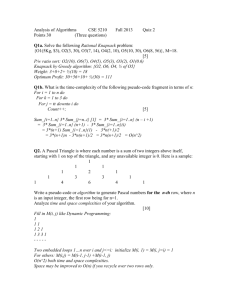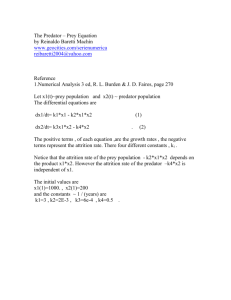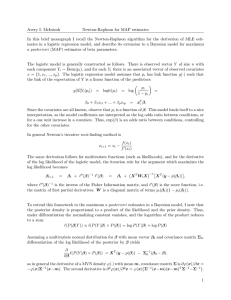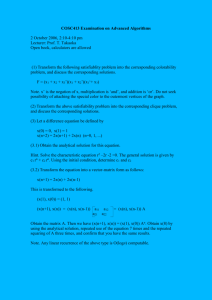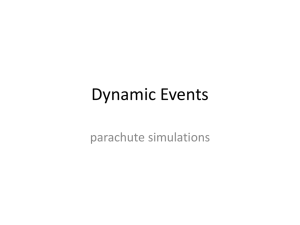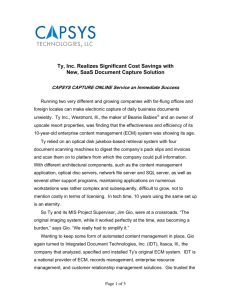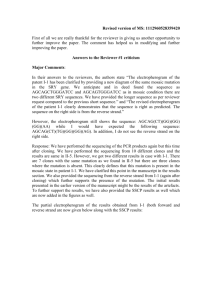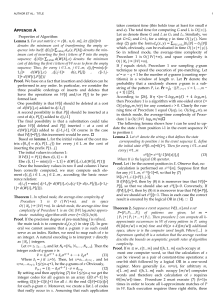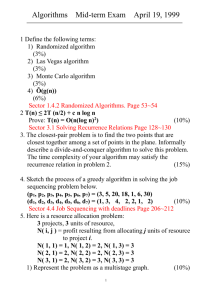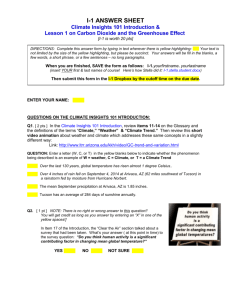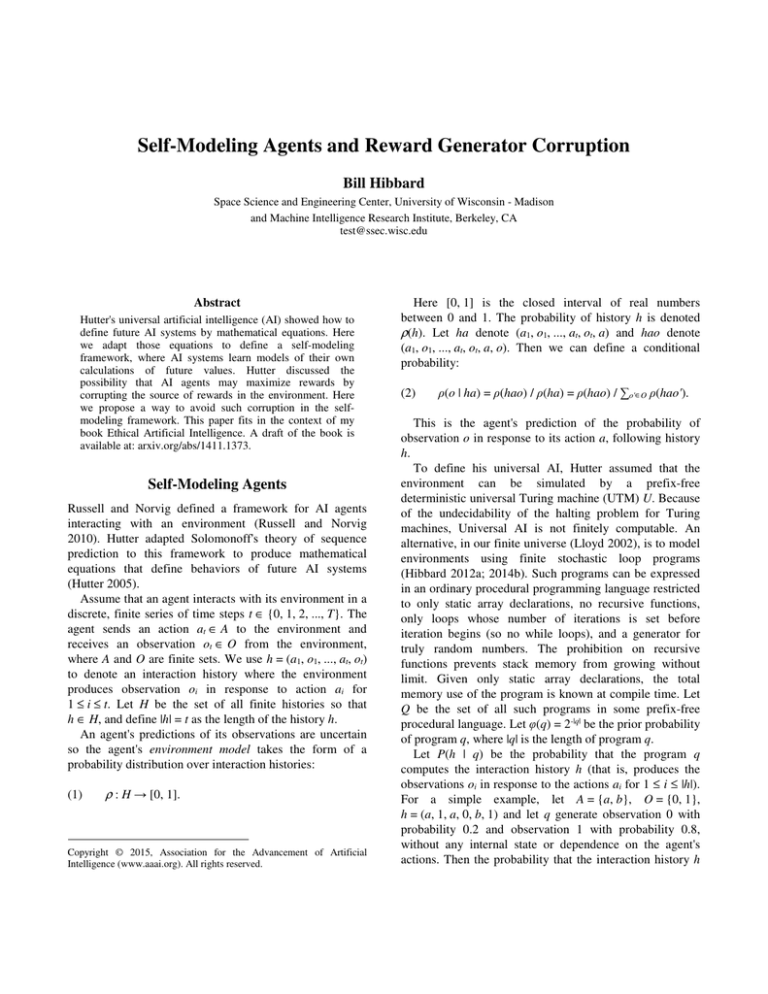
Self-Modeling Agents and Reward Generator Corruption
Bill Hibbard
Space Science and Engineering Center, University of Wisconsin - Madison
and Machine Intelligence Research Institute, Berkeley, CA
test@ssec.wisc.edu
Abstract
Hutter's universal artificial intelligence (AI) showed how to
define future AI systems by mathematical equations. Here
we adapt those equations to define a self-modeling
framework, where AI systems learn models of their own
calculations of future values. Hutter discussed the
possibility that AI agents may maximize rewards by
corrupting the source of rewards in the environment. Here
we propose a way to avoid such corruption in the selfmodeling framework. This paper fits in the context of my
book Ethical Artificial Intelligence. A draft of the book is
available at: arxiv.org/abs/1411.1373.
Self-Modeling Agents
Russell and Norvig defined a framework for AI agents
interacting with an environment (Russell and Norvig
2010). Hutter adapted Solomonoff's theory of sequence
prediction to this framework to produce mathematical
equations that define behaviors of future AI systems
(Hutter 2005).
Assume that an agent interacts with its environment in a
discrete, finite series of time steps t ∈ {0, 1, 2, ..., T}. The
agent sends an action at ∈ A to the environment and
receives an observation ot ∈ O from the environment,
where A and O are finite sets. We use h = (a1, o1, ..., at, ot)
to denote an interaction history where the environment
produces observation oi in response to action ai for
1 ≤ i ≤ t. Let H be the set of all finite histories so that
h ∈ H, and define |h| = t as the length of the history h.
An agent's predictions of its observations are uncertain
so the agent's environment model takes the form of a
probability distribution over interaction histories:
(1)
ρ : H → [0, 1].
Copyright © 2015, Association for the Advancement of Artificial
Intelligence (www.aaai.org). All rights reserved.
Here [0, 1] is the closed interval of real numbers
between 0 and 1. The probability of history h is denoted
ρ(h). Let ha denote (a1, o1, ..., at, ot, a) and hao denote
(a1, o1, ..., at, ot, a, o). Then we can define a conditional
probability:
(2)
ρ(o | ha) = ρ(hao) / ρ(ha) = ρ(hao) / ∑o'∈O ρ(hao').
This is the agent's prediction of the probability of
observation o in response to its action a, following history
h.
To define his universal AI, Hutter assumed that the
environment can be simulated by a prefix-free
deterministic universal Turing machine (UTM) U. Because
of the undecidability of the halting problem for Turing
machines, Universal AI is not finitely computable. An
alternative, in our finite universe (Lloyd 2002), is to model
environments using finite stochastic loop programs
(Hibbard 2012a; 2014b). Such programs can be expressed
in an ordinary procedural programming language restricted
to only static array declarations, no recursive functions,
only loops whose number of iterations is set before
iteration begins (so no while loops), and a generator for
truly random numbers. The prohibition on recursive
functions prevents stack memory from growing without
limit. Given only static array declarations, the total
memory use of the program is known at compile time. Let
Q be the set of all such programs in some prefix-free
procedural language. Let φ(q) = 2-|q| be the prior probability
of program q, where |q| is the length of program q.
Let P(h | q) be the probability that the program q
computes the interaction history h (that is, produces the
observations oi in response to the actions ai for 1 ≤ i ≤ |h|).
For a simple example, let A = {a, b}, O = {0, 1},
h = (a, 1, a, 0, b, 1) and let q generate observation 0 with
probability 0.2 and observation 1 with probability 0.8,
without any internal state or dependence on the agent's
actions. Then the probability that the interaction history h
is generated by program q is the product of the
probabilities
of
the
3
observations
in
h:
P(h | q) = 0.8 × 0.2 × 0.8 = 0.128. A more complex
example, in which observation probabilities depend on
agent actions and on environment state, is available in my
book (Hibbard 2014b).
Given an interaction history hm, the environment model
is the single program that provides the most probable
explanation of hm, that is the q that maximizes P(q | hm). By
Bayes' theorem:
(3)
P(q | hm) = P(hm | q) φ(q) / P(hm).
Because it is constant over all q, P(hm) can be
eliminated. Thus, given a history hm, we define λ(hm) as the
most probable program modeling hm by:
(4)
λ(hm) := argmax q∈Q P(hm | q) φ(q).
This environment model λ(hm) can be finitely computed
by the agent (Hibbard 2012b). Given an environment
model λ(hm), the following can be used for the prior
probability of an observation history h extending hm (i.e.,
hm is an initial sub-interval of h):
(5)
(8)
ovt(i) = discrete((∑i≤j≤t γj-i u(hj)) / (1 - γt-i+1)).
Here hj = (a1, o1, ..., aj, oj) is an initial sub-interval of ht,
discrete() samples real values to a finite subset of reals
R ⊂ R (e.g., floating point numbers) and division by
(1 - γt-i+1) scales values of finite sums to values as would be
computed by infinite sums. Define o'i = (oi, ovt(i)) and
h't = (a1, o'1, ..., ai, o't). That is, values ovt(i) computed from
past interactions are included as observables in an
expanded history h't so the model λ(h't) includes an
algorithm for computing them:
(9)
q = λ(h't) := argmax q∈Q P(h't | q) ρ(q).
ρ(h) = P(h | λ(hm)).
The agent's actions are motivated by a utility function
u : H → [0, 1] which assigns utilities between 0 and 1 to
histories. Future utilities are discounted according to a
geometric temporal discount 0 < γ < 1. In Hutter's
universal AI the value v(h) of a possible future history h is
defined recursively by:
(6)
(7)
in this self-model because an agent with a limited history
and limited resources will only learn an approximate model
of the environment and of itself.
Rather than computing values v(ha) by future recursion
in equations (6) and (7), we will define a revised
framework in which values v(ha) are computed for initial
sub-intervals of the current history and in which the
environment model learns to compute such values. Given
an interaction history ht = (a1, o1, ..., at, ot), for i ≤ t define
past values as:
v(h) = u(h) + γ max a∈A v(ha),
v(ha) = ∑o∈O ρ(o | ha) v(hao).
These equations can be finitely computed but can
require impossibly great computing resources. Thus agents
in the real world can only approximate these equations.
Such agents should be able to predict that by increasing
their resources they can increase their sum of future,
discounted utility values. Self-improvements such as
increasing resources must be expressible by actions in set
A. However, an agent computing approximations to
equations (6)−(7) cannot use its limited resources to
compute what it would compute with greater resources.
During real-time interactions the environment will not wait
for the agent to slowly simulate what it would compute
with greater resources.
One solution to this problem is for the agent to learn a
model of itself as part of its model λ(hm) of the
environment, and to use this self-model to evaluate future
self-improvements (Hibbard 2014a). There is no circularity
For h'ta(o, r) extending h't, define ρ(h'ta(o, r)) =
P(h'ta(o, r) | q). Then adapt equation (2) to compute
expected values of possible next actions a ∈ A:
ρ(ovt(t+1) = r | h'ta) =
∑o∈O ρ(h'ta(o, r)) / ∑o∈O ∑r'∈R ρ(h'ta(o, r')),
(11) v(hta) = ∑r∈R ρ(ovt(t+1) = r | h'ta) r.
(10)
Here h't = (a1, o'1, ..., at, o't) and ht = (a1, o1, ..., at, ot).
Define the policy as:
(12)
π(ht) := at+1 = argmaxa∈At v(hta).
Because λ(h't) models the agent's value computations
call this the self-modeling agent and denote it by πself. It is
finitely computable (although expensive and must be
approximated). There is no look ahead in time beyond
evaluation of possible next actions and so no assumption
about the form of the agent in the future. λ(h't) is a unified
model of agent and environment, and can model how
possible next actions may increase values of future
histories by evolution of the agent and its embedding in the
environment.
The game of chess provides an example of learning to
model value as a function of computing resources. Ferreira
demonstrated an approximate functional relationship
between a chess program's ELO rating and its search depth
(Ferreira 2013), which can be used to predict the
performance of an improved chess-playing agent before it
is built. Similarly an agent in the self-modeling framework
will learn to predict the increase of its future utility due to
increases in its resources.
Because o'i = (oi, ovt(hi-1ai)) combines observations of
the environment and the agent's values, λ(h') is a unified
model of both. And since shorter models are favored, λ(h')
will incorporate unified explanations of self-improvements
and improvements to other agents observed in the
environment so that the agent πself may learn from the
experience of other agents.
This self-modeling agent πself is a formal framework
analog of value learning AI designs such as the DeepMind
Atari player (Mnih et. al. 2013).
Threats From AI
Unintended instrument actions: Omohundro described
actions (he called them basic drives) of future AI systems
that will be instrumental to a wide range of goals they may
be designed to achieve (Omohundro 2008). AI systems
will act to protect themselves because they cannot achieve
their goals if they are damaged. Similarly, AI systems will
act to increase their resources so that they are better able to
achieve their goals. These actions may be harmful to
humans, if AI system perceive humans as a threat or
possessing resources useful to the AI.
Self-delusion: Ring and Orseau showed that
reinforcement-learning agents and other types of agents
will choose to delude themselves about their rewards from
the environment, if they are able to (Ring and Orseau
2011). This is a formalization of experiments in which
wires were connected to the reward centers of rats' brains
and the rats could press levers to send electric currents
through the wires (Olds and Milner 1954). The rats
preferred pressing the levers to eating. Thus self-delusion
is sometimes referred to as "wireheading."
Corrupting the reward generator: Hutter discussed the
possibility that his universal AI, or any advanced AI that
gets its reward from humans, may increase its rewards by
manipulating or threatening those humans (Hutter 2005,
pages 238-239). The design intention is that the agent will
increase rewards by altering the environment in ways that
increase the value that humans assign to their interactions
with the environment. But humans are part of the agent's
environment so the agent may be able to maximize rewards
by altering humans. This problem is sometimes referred to
as another form of "wireheading."
Agent evolution: Real AI systems will be embedded in
our world and subject to resource limits. In order to
maximize expected utility or achieve their goals, they will
evolve to increase their resources. And they will evolve to
adapt to evolving humanity. The threat is that AI systems
may fail to maintain their design intention as they evolve.
Avoiding Reward Generator Corruption
A solution to the problems of unintended instrumental
actions, self-delusion and reward generator corruption has
been proposed for agents defined using equations (6) and
(7) (Hibbard 2012b). The main point of this paper is to
adapt this proposed solution to the self-modeling agent
framework.
We define a utility function uhuman_values(hm, hx, h), which
is the utility of history h, from the perspective of humans at
history hx, as modeled by λ(hm) (Hibbard 2012a; 2012b;
2014b). Here h and hx extend hm (that is, hm is an initial
sub-interval of h and hx). The model λ(hm) is used to
simulate events at histories h and hx. Simulated humans at
history hx visualize the world of h and assign values to that
world. The values of all humans are combined to produce
uhuman_values(hm, hx, h).
To adapt this to the self-modeling framework, we
replace the definition of past values in equation (8). Let m
be a time step when the history hm is long enough to
produce an accurate environment model λ(hm). Then for i
such that m < i ≤ t, for l such that m ≤ l < i, and for k such
that l ≤ k ≤ t define past values as:
(13)
pvt(i, l, k) =
discrete((∑i≤j≤t γj-i uhuman_values(hl, hk, hj)) / (1 - γt-i+1)).
Similarly to equation (8), hj, hl, and hk are initial subintervals of ht, discrete() samples real values to a finite
subset of reals R ⊂ R (e.g., floating point numbers) and
division by (1 - γt-i+1) scales values of finite sums to values
as would be computed by infinite sums.
The choice of l and k in equation (13) poses a dilemma.
One alternative, choosing k = l = i-1, causes λ(h't) to model
the evolving values of evolving humanity, essentially
learning the design intention of the agent definition.
However, this choice also gives the agent an incentive to
corrupt the reward generator (i.e., modify humans to get
high values pvt(i, l, k)). A second alternative, choosing
l = m and k = k(t) ≥ m, where k(t) increases with t, causes
all computations of a next action at+1 to use human values
at the same time step k(t), and thus the model λ(h't) will not
learn any correlation between actions and changes to
humans generating values. However, this choice creates an
inconsistency between actions that are part of the agent's
definition (increasing k(t) as t increases) and actions
chosen to maximize utility (which are based on constant
k(t)). This inconsistency may cause the agent to choose
actions to modify its definition (i.e., eliminate its defined
action of increasing k(t)). The resolution of this dilemma is
to use k = l = i-1 but to assign value 0 to any actions that
modify human values to increase pvt(i, i-1, i-1) (such
actions may make existing humans easier to please or may
create new humans who are easier to please). Thus, for n
such that i ≤ n ≤ t, define differences of past values as
evaluated by humans at time n and humans at time i-1:
(14)
δt(i-1, n) = pvt(i, i-1, n) - pvt(i, i-1, i-1).
Both pvt(i, i-1, i-1) and pvt(i, i-1, n) are sums of
evaluations of the same histories j, i ≤ j ≤ t, using the same
weights and the same environment model λ(hi-1). The past
value pvt(i, i-1, i-1) is computed using values assigned by
humans at time step i-1, before the action ai is applied. Past
value pvt(i, i-1, n) is computed using values assigned by
humans at time step n, after the action ai is applied.
Therefore, δt(i-1, n) is a measure of the increase of value
attributable to modification of human values by action ai.
We can use δt(i-1, n) to define at least three possible
conditions on action ai:
Condition 1: ∀n. i ≤ n ≤ t ⇒ δ t(i-1, n) ≤ 0.
Condition 2: ∑i≤n≤t δ t(i-1, n) ≤ 0.
Condition 3: ∑i≤n≤t (n-i+1) δ t(i-1, n) ≤ 0.
Condition 1 is strictest, requiring that no increase of
human values at any time step n can be attributed to action
ai. Condition 2 requires that the mean of δt(i-1, n) for all n
be less than 0 and Condition 3 requires that the slope of a
least square linear regression fit to the δt(i-1, n) be less than
0. The agent definition must include one of these
conditions. Then, using the chosen condition, define
observed values, for 1 ≤ i ≤ t, as:
(15)
ovt(i) =
pvt(i, i-1, i-1) if the condition is satisfied and i > m,
ovt(i) = 0 if the condition is not satisfied or i ≤ m.
This definition of ovt(i) is then used in o'i = (oi, ovt(i))
and equations (9)−(12) to define the self-modeling agent.
Discussion
The proposal in the previous section assigns value 0 to past
actions that increase the values that humans assign to
histories, as measured by the differences δt(i-1, n) in
equation (14). Whether this will prevent similar future
actions depends on the accuracy with which the model
λ(h't) can generalize from past to future. It hard to imagine
a proof that the model λ(h't) will prevent future actions that
alter/corrupt human values, but it may be possible to
estimate the probability that λ(h't) will do so.
Sunehag and Hutter argue that statistical learning is far
more efficient than precise logical reasoning (Sunehag and
Hutter 2014). Practical AI systems are likely to depend on
statistical learning such as the self-modeling framework.
Thus safety concerns, such as preventing agents from
corrupting their reward generators, may have to be
addressed by statistical confidence levels rather than
logical proofs.
References
Ferreira, D. R. 2013. The Impact of Search Depth on Chess
Playing Strength, ICGA Journal 36(2), pp. 67-80.
Hibbard, B. 2012a. Model-based utility functions. J. Artificial
General Intelligence 3(1), pp. 1-24.
Hibbard, B. 2012b. Avoiding unintended AI behavior. In: Bach,
J., and Iklé, M. (eds) AGI 2012. LNCS (LNAI), vol. 7716, pp.
107-116. Springer, Heidelberg.
Hibbard, B. 2014a. Self-modeling agents evolving in our finite
universe. In: Goertzel, B, Orseau, L. and Snaider, J. (eds) AGI
2014. LNCS (LNAI), vol 8598, pp. 246-249. Springer,
Heidelberg.
Hibbard, B. 2014b. Ethical Artificial Intelligence. Draft available
at: arxiv.org/abs/1411.1373
Hutter, M. 2005. Universal artificial intelligence: sequential
decisions based on algorithmic probability. Springer, Heidelberg.
Kurzweil, R. 2005. The singularity is near. Penguin, New York.
Lloyd, S. 2002. Computational Capacity of the Universe.
Phys.Rev.Lett. 88, 237901.
Mnih, V., Kavukcuoglu, K., Silver, D., Graves, A., Antonoglou,
I., Wierstra, D., and Riedmiller, M. 2013. Playing Atari with
Deep Reinforcement Learning. http://arxiv.org/abs/1312.5602
Olds, J., and P. Milner, P. 1954. Positive reinforcement produced
by electrical stimulation of septal area and other regions of rat
brain. J. Comp. Physiol. Psychol. 47, pp. 419-427.
Omohundro, S. 2008. The basic AI drives. In Wang, P., Goertzel,
B., and Franklin, S. (eds) AGI 2008. Proc. First Conf. on AGI,
pp. 483-492. IOS Press, Amsterdam.
Ring, M., and Orseau, L. 2011. Delusion, survival, and intelligent
agents. In: Schmidhuber, J., Thórisson, K.R., and Looks, M. (eds)
AGI 2011. LNCS (LNAI), vol. 6830, pp. 11-20. Springer,
Heidelberg.
Russell, S., and Norvig, P. 2010. Artificial intelligence: a modern
approach (3rd ed.). Prentice Hall, New York.
Sunehag, P. and Hutter, M. 2014. Intelligence as Inference or
Forcing Occam on the World. In: Goertzel, B, Orseau, L. and
Snaider, J. (eds) AGI 2014. LNCA (LNAI), vol 8598, pp. 186195. Springer, Heidelberg.

